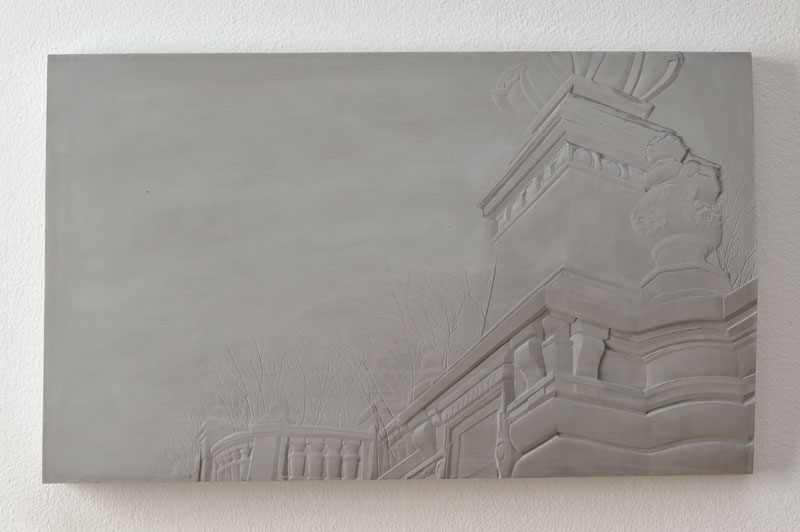
January, 2012
Sarah Bostwick: "Grey Area" at Gregory Lind Gallery
by Dewitt Cheng

Brussels Monument, 2011
Hydrocal, pigment
9 1/4" x 15 1/4" x 1 1/2"
Photo: courtesy Gregory Lind Gallery
"Art does not progress; it changes," opines Sir Anthony Blunt, the renowned English art historian, in Alan Bennett's play, "A Question of Attribution." A spy for the USSR, the real Blunt--misnamed, naturally--knew well that appearance and reality need not coincide, and that cultural fashion is arbitrary. Sarah Bostwick's revisionism in "Grey Area" will probably not horrify anyone today, given the pluralist climate, even if it revives--single-handedly, to my knowledge--the representational bas-relief that we associate with Egypt, Rome and Assyria, and had thought buried forever behind the flat picture plane. (Camille Lefebvre's 1907 Monument to Emile Levassor, a deeply carved, eye-popping marble relief depicting an auto race, is a marvelous anachronism: 3D, old-school.)
Bostwick's seven reliefs are made of carved, cast, pigmented Hydrocal plaster or resin: each one a monochrome white, gray, or black. The result is both elegant and introspective. Intrigued by night photography, the artist has set aside her sculptural concerns, which seemed destined for installationist expansionism, to explore pictorial paradox instead: her handsomely crafted urban views manifest the elegant perspectival realism of old, but suggest now. Instead of architectural deconstruction, they suggest modernist architecture enveloped in or hewn from stone, calcified and fossilized, or seen through archaic eyes. Union Square 4 5 6 depicts three levels of the New York City subway station as a tapestry of interwoven columns and cages, its shallow gray spaces expertly delineated but spatially impenetrable--an exquisitely claustrophobic maze. Katonah is a tour de force of modeling that implies topography conquering geometry, with a house nearly sunk into the leafy picture plane, only a corner still afloat. The similarly conceived Brussels Monument--commemorating what?--seems similarly overgrown and reclaimed. A more balanced view emanates from Queens Garden, with its deep-relief flora set against shallow-relief walls and architecture. Two lighter-toned works depict architecture unthreatened, but frozen: Fluorescence depicts a long, low shed above which telephone wires and foliage or clouds perch, all crystallized into alabaster; Cellar Floor Right, depicting a domestic interior with a prominent radiator, was aptly made for a show about time standing still.